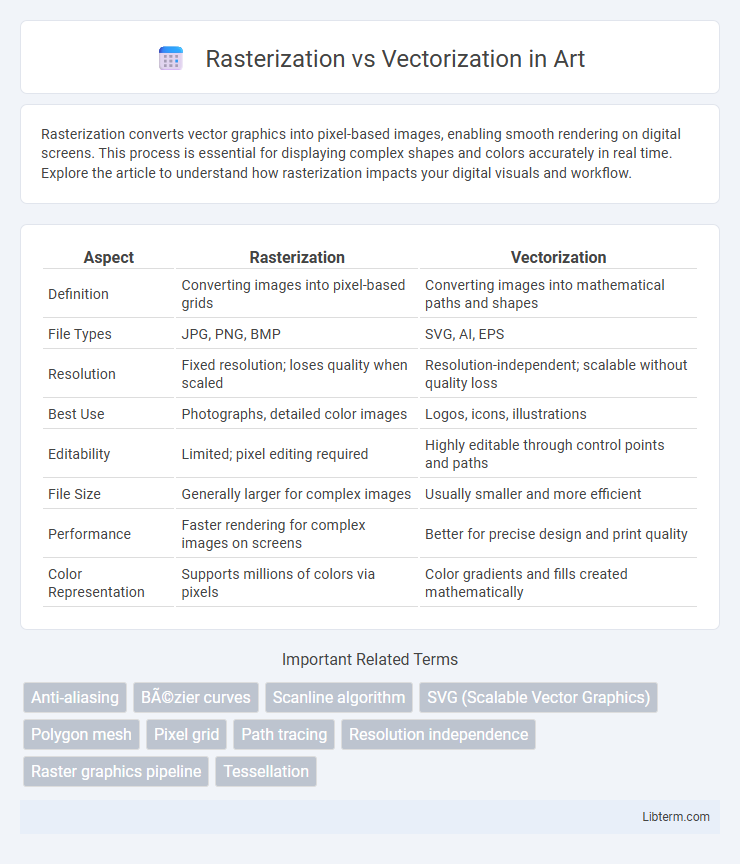Rasterization converts vector graphics into pixel-based images, enabling smooth rendering on digital screens. This process is essential for displaying complex shapes and colors accurately in real time. Explore the article to understand how rasterization impacts your digital visuals and workflow.
Table of Comparison
| Aspect | Rasterization | Vectorization |
|---|---|---|
| Definition | Converting images into pixel-based grids | Converting images into mathematical paths and shapes |
| File Types | JPG, PNG, BMP | SVG, AI, EPS |
| Resolution | Fixed resolution; loses quality when scaled | Resolution-independent; scalable without quality loss |
| Best Use | Photographs, detailed color images | Logos, icons, illustrations |
| Editability | Limited; pixel editing required | Highly editable through control points and paths |
| File Size | Generally larger for complex images | Usually smaller and more efficient |
| Performance | Faster rendering for complex images on screens | Better for precise design and print quality |
| Color Representation | Supports millions of colors via pixels | Color gradients and fills created mathematically |
Introduction to Rasterization and Vectorization
Rasterization converts vector graphics into a grid of pixels, enabling display on raster-based devices like monitors and printers by assigning color values to each pixel. Vectorization transforms pixel-based images into scalable vector paths using mathematical equations, facilitating infinite resizing without loss of quality. Understanding the fundamental differences between pixel-based raster images and mathematically defined vector graphics is essential for applications in computer graphics, digital illustration, and image processing.
Fundamental Concepts: Pixels vs. Paths
Rasterization converts images into pixels, arranging tiny colored squares in a grid to represent visuals with precise detail but fixed resolution. Vectorization uses mathematical paths defined by points, lines, and curves to create scalable graphics that maintain crisp quality at any size. Pixels dominate raster images suitable for complex color variations, while vector paths excel in logos and illustrations requiring smooth edges and infinite scalability.
Key Differences Between Raster and Vector Graphics
Raster graphics are composed of pixels arranged in a grid, making them resolution-dependent and ideal for complex images like photographs but prone to quality loss when scaled. Vector graphics use mathematical formulas to create shapes and lines, enabling infinite scalability without losing clarity, which is perfect for logos and illustrations. The primary differences lie in scalability, resolution dependence, and file size efficiency, with raster images typically larger and vector files being more compact and editable.
Advantages of Rasterization
Rasterization converts vector graphics into pixel-based images, enabling precise control over color depth and shading, which enhances detailed texture rendering in digital art and video games. It allows for faster processing and display on most screens and printers since pixel grids align directly with hardware capabilities. This method is especially advantageous for complex images with subtle gradients, as it ensures consistent visual output across various devices.
Advantages of Vectorization
Vectorization offers significant advantages such as scalability without loss of image quality, allowing graphics to be resized infinitely with sharp edges and clear details. Vector graphics use mathematical equations to represent images, which results in smaller file sizes compared to raster images composed of pixels. This format is ideal for logos, icons, and other designs that require precision and versatility across different media and devices.
Use Cases for Raster Graphics
Raster graphics excel in detailed image rendering, making them ideal for photographs and complex digital paintings that require rich color depth and subtle shading. Their pixel-based structure suits applications such as web graphics, digital photography, and photo editing where precise control over each pixel is necessary. Raster formats like JPEG, PNG, and GIF are widely used in online media, ensuring compatibility and vibrant display across various digital platforms.
Use Cases for Vector Graphics
Vector graphics excel in design fields requiring scalability and precision, such as logo creation, typography, and CAD modeling, where maintaining image quality at any size is crucial. They are optimal for digital illustrations, animations, and user interface elements due to their small file sizes and easy editability. Vector formats like SVG and EPS are preferred in printing and web development for sharp, resolution-independent visuals.
Performance and Scalability Comparison
Rasterization processes images as pixel grids, offering fast rendering speeds that scale linearly with image resolution but often result in larger file sizes and quality loss when scaling up. Vectorization uses mathematical equations to represent graphics, enabling infinite scalability and superior quality at any size with smaller file sizes, but it demands more computational resources during rendering, which can impact performance on complex images. Performance in rasterization excels in real-time applications with static resolutions, while vectorization scales better for diverse display sizes and complex graphics, providing efficient scalability for varied devices and resolutions.
Quality and File Size Considerations
Rasterization converts images into pixels, resulting in high-quality details at fixed resolutions but larger file sizes that increase with image complexity. Vectorization represents images using mathematical paths, enabling infinite scalability without quality loss and typically producing smaller file sizes optimized for logos and illustrations. Choosing between raster and vector formats depends on the need for resolution independence versus precise, pixel-based detail and manageable file size requirements.
Choosing the Right Approach for Your Project
Rasterization converts images into a grid of pixels, ideal for detailed photographs and complex color gradients, while vectorization uses mathematical paths to create scalable and resolution-independent graphics, perfect for logos and illustrations. Choosing the right approach depends on your project's needs for scalability, file size, and editability; raster formats suit high-resolution images, whereas vector formats excel in resizing without quality loss. Evaluate factors like target media, required detail, and future modifications to ensure optimal visual quality and performance.
Rasterization Infographic

 libterm.com
libterm.com